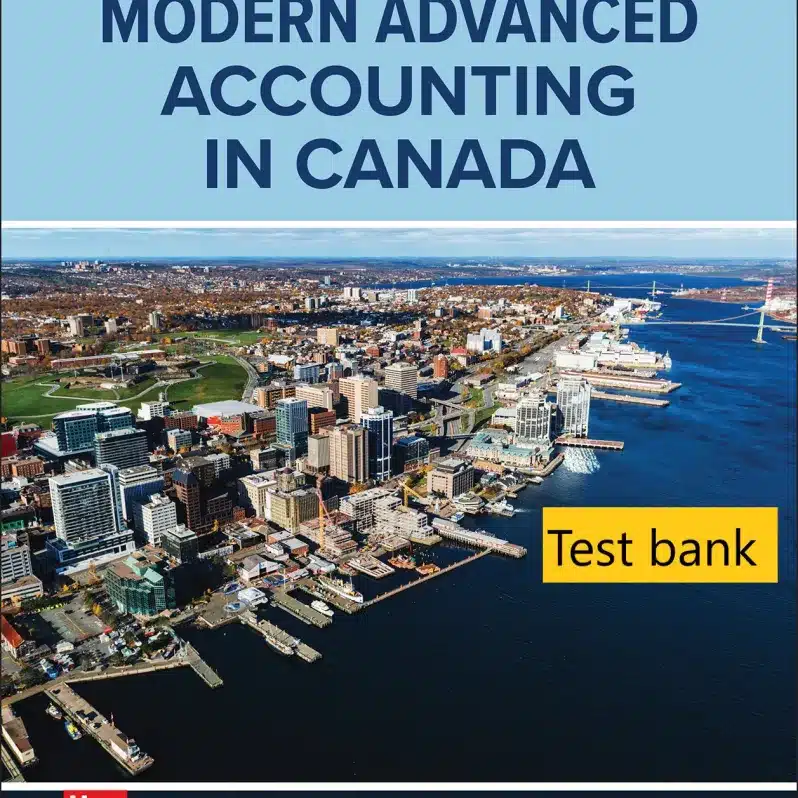Original price was: $39.99.$29.99Current price is: $29.99.
Test bank for Modern Advanced Accounting In Canada 11th Edition By Darrell Herauf
Product ID: 0921100
For Contact: bookzon.shop@gmail.com
Description
Test Bank for Modern Advanced Accounting in Canada, 11th Edition
By Darrell Herauf
Overview of the Book
The 11th Edition of Modern Advanced Accounting in Canada by Darrell Herauf is widely recognized as one of the most technically accurate and up-to-date texts in advanced accounting. This edition continues to be a trusted and reliable resource for advanced accounting courses, providing both students and instructors with a comprehensive, detailed approach to the complexities of modern accounting practices in Canada.
This 11th Edition is fully compliant with International Financial Reporting Standards (IFRS), covering key topics such as business combinations, foreign currency transactions, and intermediate accounting concepts. It also includes the reporting requirements for private enterprises and not-for-profit organizations, making it a well-rounded resource for various accounting practices. Additionally, all the financial statement extracts used throughout the text are taken from Canadian entities, ensuring the material is relevant and applicable to the Canadian accounting landscape.
Herauf and Hilton’s emphasis on the direct approach to preparing consolidated financial statements and the “building block” development of consolidations continues to be a cornerstone of the text, helping students understand the underlying principles of complex accounting processes.
Key Features of the 11th Edition
Comprehensive IFRS Compliance
The 11th Edition is designed to be 100% compliant with International Financial Reporting Standards (IFRS), addressing typical advanced accounting topics such as business combinations, foreign currency transactions, and more. This ensures that students are learning the most current global standards and practices in financial reporting.
Canadian Context and Relevance
Unlike many other accounting textbooks, this edition is tailored specifically to the Canadian accounting environment. It uses Canadian financial statements and examples, ensuring the content is directly applicable to those studying accounting in Canada. The text also includes reporting requirements for private enterprises and not-for-profit organizations in Canada.
Focus on Consolidation and Business Combinations
The textbook continues to emphasize the preparation of consolidated financial statements, providing a step-by-step guide that builds a strong foundation for students. This direct approach is reinforced with examples of business combinations, consolidation of subsidiaries, and the complexities involved in both.
Expanded Coverage of Key Accounting Topics
The 11th Edition introduces expanded content on topics such as foreign currency transactions, accounting for not-for-profit organizations, and more, reflecting the evolving nature of the accounting field.
Table of Contents
Chapter 1: Conceptual and Case Analysis Frameworks for Financial Reporting
This chapter introduces the fundamental frameworks used in financial reporting, focusing on conceptual models and case analyses to help students understand the principles behind financial statements and their preparation.
Chapter 2: Investments in Equity Securities
Here, students learn about the accounting for equity securities and how to classify and report investments in other companies’ shares, including marketable and non-marketable securities.
Chapter 3: Business Combinations
An essential chapter that covers the accounting for business combinations, including the purchase method, goodwill, and fair value adjustments in the context of mergers and acquisitions.
Chapter 4: Consolidation of Non–Wholly Owned Subsidiaries
This chapter explores the consolidation process when a parent company does not own 100% of a subsidiary, addressing challenges like minority interests and partial ownership.
Chapter 5: Consolidation Subsequent to Acquisition Date
Focuses on the post-acquisition phase of consolidation, including how to handle subsequent transactions between the parent and subsidiary companies.
Chapter 6: Intercompany Inventory and Land Profits
This chapter deals with the elimination of intercompany profits, specifically related to inventory and land transactions within the consolidated group.
Chapter 7: (A) Intercompany Profits in Depreciable Assets (B) Intercompany Bondholdings
Divided into two parts, this chapter addresses intercompany profits on depreciable assets and how to handle intercompany bondholdings during consolidation.
Chapter 8: Consolidated Cash Flows and Changes in Ownership
Students will learn about consolidated cash flows, how changes in ownership impact the consolidated cash flow statement, and the elimination of intercompany transactions.
Chapter 9: Other Consolidation Reporting Issues
This chapter covers additional challenges in consolidation reporting, such as handling complex transactions and non-controlling interests.
Chapter 10: Foreign Currency Transactions
Explores how to account for foreign currency transactions, including the conversion of foreign currency into the Canadian dollar and the accounting treatment for exchange rate fluctuations.
Chapter 11: Translation and Consolidation of Foreign Operations
Students will learn how to translate the financial statements of foreign operations and consolidate them into the parent company’s financial statements.
Chapter 12: Accounting for Not-for-Profit and Public Sector Organizations
This chapter introduces the unique accounting methods used for not-for-profit organizations and public sector entities, focusing on the differences from for-profit accounting practices.
For more Test banks, click here.






Supports success
Great investment
Very useful
Easy to understand
Detailed explanation